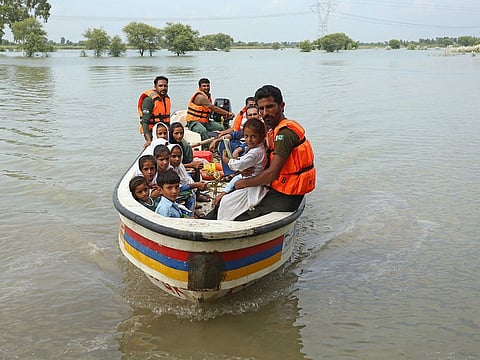Washed Away: Pakistan faces escalating rains, floods as climate crisis deepens
With over 70 dead in 10 days, Pakistan faces the brutal reality of rising temperatures

Dubai: As heavy monsoon rains lash Pakistan for a second week, flash floods have killed at least 72 people and injured over 130, with Khyber Pakhtunkhwa province reporting the highest number of fatalities.
The National Disaster Management Authority (NDMA) of Pakistan confirmed damage to hundreds of homes and the loss of thousands of livestock as swollen rivers and mountain streams swept through rural communities.
The rains, which began on June 26, have triggered widespread devastation across Punjab, Sindh, Balochistan, Jammu and Kashmir, and Gilgit-Baltistan.
Yet, the NDMA warns the worst may not be over, with alerts issued for continued rain and flooding through July. Rising water levels in major rivers such as the Indus, Chenab, Swat, and Jhelum threaten to overwhelm already fragile infrastructure.
Climate change fuels extreme weather
Pakistan is no stranger to floods, but experts say the intensity and frequency of these disasters are increasing dramatically due to climate change. The country, already ranked among the most vulnerable globally, is experiencing heavier monsoon rainfall, rapid glacial melt, and unpredictable weather patterns. According to the Climate Risk Index 2025 by Germanwatch, Pakistan is the most climate-vulnerable country in the world, despite contributing less than 1% of global greenhouse gas emissions.
The 2022 floods, widely regarded as the worst in the country's history, displaced over 33 million people, killed more than 1,700, and caused $40 billion in damages. That disaster was largely fueled by record-breaking monsoon rainfall and glacial lake outburst floods (GLOFs), both linked to a warming planet.
Scientists estimate that climate change increased the severity of that year’s monsoon rains by 50%.
Floods and droughts
Pakistan's geography and topography make it especially prone to climate-related disasters. Mountain glaciers are melting at unprecedented rates, and extreme precipitation events are becoming more common.
The country has already witnessed significant economic and social fallout from a long history of catastrophic floods.
Looking ahead, the future is even more alarming. By 2044, five million people are expected to be exposed to extreme river flooding annually. Coastal regions may see one million people affected by sea-level rise and saltwater intrusion. Temperature increases of 3°C by 2040 and possibly up to 6°C by century’s end could severely disrupt agriculture, threaten water security, and amplify food insecurity and poverty, especially in rural areas.
Flooded fields to empty taps
Paradoxically, while floods inundate vast swathes of land, Pakistan is also running dry. The country, once water-abundant in the 1980s, is now among the top 15 most water-stressed nations and is projected to face outright water scarcity by 2035.
Climate-induced disasters are deepening this crisis by contaminating water sources, damaging infrastructure, and worsening the spread of waterborne diseases like cholera, dengue, and diarrhoea.
For millions of Pakistanis, particularly in flood-prone regions, the cycle of displacement and disaster is becoming a grim annual ordeal. Communities already grappling with poverty now face growing uncertainty, climate anxiety, and the risk of cascading disasters—from malnutrition to forced migration.
Urgency for action
Experts warn that Pakistan needs sustainable and operational flood management systems, along with resilient infrastructure and climate adaptation strategies. Poor urban planning and extractive political institutions have historically magnified the impact of natural disasters, but the margin for error is shrinking.
As monsoon clouds continue to gather, Pakistan is not just battling rain, it is battling the accelerating reality of climate collapse.
Also Read: Pakistan and Oman launch ferry link plans
Sign up for the Daily Briefing
Get the latest news and updates straight to your inbox



